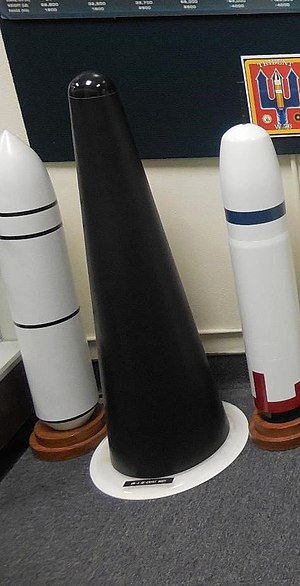W68
| W68 | |
|---|---|
 A W68 warhead in a Mk3 reentry Body. See image below for scale. | |
| Type | Nuclear weapon |
| Service history | |
| In service | 1971-1991 |
| Used by | United States. |
| Production history | |
| Designer | Lawrence Livermore National Laboratory |
| Produced | June 1970 - June 1975 |
| No. built | 5250 |
| Specifications | |
| Mass | 367 pounds (166 kg) |
Detonation mechanism | Contact, airburst |
| Blast yield | 40 kilotonnes of TNT (170 TJ) |

The W68 warhead was the warhead used on the UGM-73 Poseidon SLBM missile. It was developed in the late 1960s at Lawrence Livermore National Laboratory.
Specifications
[edit]The W68 weighed 367 pounds (166 kg)[1] and had an official design yield of 40 kilotonnes of TNT (170 TJ).[2]
The design was revolutionary and impacted many following systems with its achievements in warhead miniaturization.[3]
The W68 had four fuzing options: low altitude radar with contact backup, high altitude radar with timer backup, high altitude timer with impact backup and impact fuzing.[4]
Production and deployment
[edit]A total of 5,250 W68 warheads were produced, the single largest production run of any American nuclear weapon model. It was manufactured starting in June 1970 and ending in June 1975. Each Poseidon missile could carry up to 14 warheads; at the peak deployment, there were 31 US Poseidon submarines with 16 missiles each, for a total of 496 deployed missiles, at a density of about 10 warheads per missile.
Safety issues and later service
[edit]Aging of the LX-09 polymer-bonded explosive used in the W68[5][6][7][8][9] led to decomposition of the explosive, separating the binder and plasticizer,[7] which then caused deterioration of the detonators. This required the whole production run to be retired or remanufactured with LX-10 and LX-10-1 as new explosives from November 1978 through 1983; about 2,000 units were retired starting in 1977 rather than rebuilt.[1]
The remaining 3,200 warheads remained in service longer, with the last units retired in 1991.[1]
See also
[edit]References
[edit]- ^ a b c Carey Sublette (2006-10-04). "Complete List of All U.S. Nuclear Weapons: W-68". Retrieved 2006-05-03.
- ^ Minutes of National Security Council Meeting (Report). Parity, Safeguard, and the SS–9 Controversy. Washington DC. 1969-05-05. p. 119.
- ^ "Accomplishments in the 1970s: LLNL's 50th Anniversary". February 17, 2005. Archived from the original on 17 February 2005.
- ^ Sandia Weapon Review: Nuclear Weapon Characteristics Handbook (PDF) (Report). Sandia National Labs. September 1990. p. 69. SAND90-1238.
- ^ "W68 warhead". globalsecurity.org. Archived from the original on 2006-09-02. Retrieved 2006-05-03.
- ^ "Warhead Accidents". Banthebomb.org. Archived from the original on 2005-11-27. Retrieved 2006-05-03.
- ^ a b Carey Sublette (1999-02-20). "4.1.6.2.2.5 Explosives". 4. Engineering and Design of Nuclear Weapons: 4.1 Elements of Fission Weapon Design. Retrieved 2006-05-03.
- ^ "LLNL explosives accident training web page". Lawrence Livermore National Laboratory (LLNL). Retrieved 2006-05-03. [dead link]
- ^ "Relatives of 3 Killed in Blast At Nuclear Plant Lose Suit". New York Times. AP. 1981-10-03. Archived from the original on 2007-03-11. Retrieved 2006-05-03.
External links
[edit]- Allbombs.html list of all US nuclear weapons at nuclearweaponarchive.org
- Lawrence Livermore Labs accomplishments in the 1970s
| Fission (including boosted) |
| ||||||||||
|---|---|---|---|---|---|---|---|---|---|---|---|
| Thermonuclear |
| ||||||||||
| Enhanced radiation |
| ||||||||||
| Primary stages | |||||||||||
| Experimental | |||||||||||
Text is available under the CC BY-SA 4.0 license; additional terms may apply.
Images, videos and audio are available under their respective licenses.
